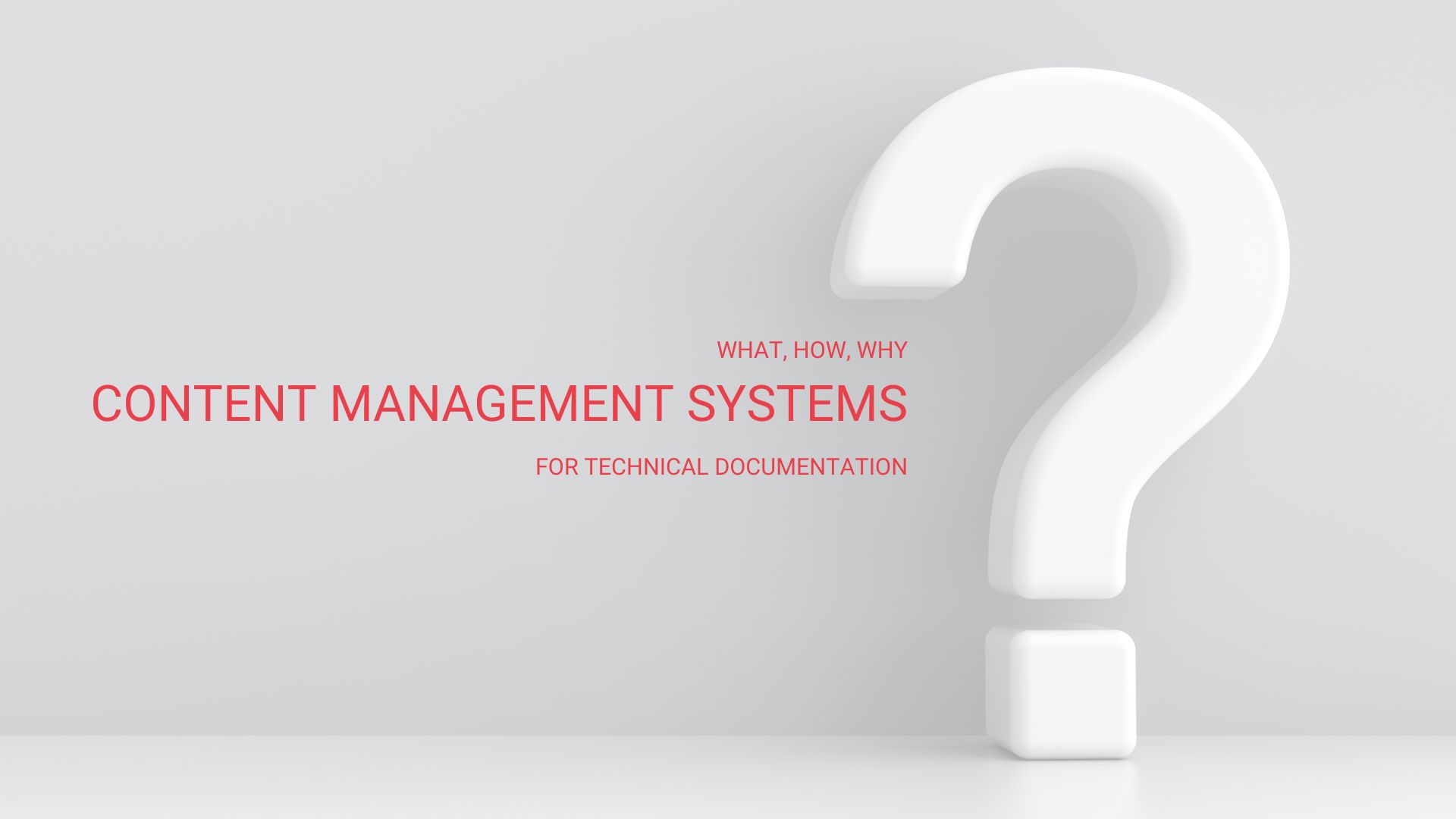"As a medium-sized mechanical engineering company, we've always written our technical documentation in a word processing program. We're slowly reaching the limit with file sizes and versioning. But is it worthwhile to introduce an entire Content Management System for technical documentation right away? Isn't that far too cumbersome and costly for us?"
First, the short answer: It can be worth it. After all, not all systems are the same.
There's quite a wide range when it comes to functional scope, complexity, but also price. The key is to find the right system for your needs.
In the following, we'd like to answer a few basic questions that should help you decide whether a CMS can make sense for your technical documentation and which aspects play a role in the decision.
What is a Content Management System for Technical Documentation?
Content Management Systems (or Component Content Management Systems (CCMS)) facilitate work in technical documentation that would otherwise require a great deal of effort and be highly error-prone. Technical documentation is authored, managed, versioned, quality-assured and output in Content Management Systems. Translation into various languages can also originate in this system.
Furthermore, CMSes Follow Three Crucial Principles that Go Hand-in-Hand.
- Modular content capture: Content is not captured in a continuous document, as with a word processor, but in smaller units called modules. These modules are stored, translated, and versioned individually and can be reused as needed. In this way, a section that has been checked and translated once (and is valid for several machines) can be used again and again, and is easily adapted if changes are made.
- Separation of layout, structure, and content: The modules are authored layout-neutrally in XML format, with the help of an (often graphical) editor. Once the content has been fully captured, the desired modules are assembled manually or semi-automatically into documents and published. Thanks to the media-neutral capture of content, output can be in many different layouts. This makes reformatting a thing of the past.
- Single source publishing: Since the content is managed layout-neutrally and centrally in one data source, it can not only be formatted differently, but also output in a wide variety of media. The most common output is PDF for printing or HTML for websites. But more exotic publication formats can also be realised. For example, content from the CMS can be published via an app or used as the basis for digital learning units in an online academy.
What does a Content Management System do for Technical Documentation?
In addition to the basic functions mentioned above, there are a number of typical functions that most Content Management Systems have:
- Status marking and version management: Each image, each module, and each document has its own status and version to ensure a completely transparent history.
- Variant management: Individual series often differ only in minor details, yet they require operating instructions that differ from one another. With the help of (e.g. variant-dependent validities and variables), content can be systematically selected and compiled. In this way, a module can be reused many times, even if some details change depending on the variant of the product described.
- Foreign language management: The translation process can be triggered directly from the system. The translated modules can in turn be imported back and managed directly in the CMS. This means that once modules have been translated, there is no need to order a new translation.
- A wide range of automatic functions for text creation: Most CMSes offer a number of practical aids, right out of the box (e.g. spell check or references to similar content that has already been entered). Some others can be implemented via appropriate interfaces (e.g. terminology checking).
- Automatic data import and export: images, product data, metadata, etc. – depending on the connected systems, different data streams can be realised. Finished documents can also be published automatically and transmitted to an ERP system or a print shop, for example.
When Does Purchasing a Content Management System First Start to Pay Off ?
In management meetings, we're often asked about the Return On Investment (ROI) for a CMS for technical documentation. Of course, this is difficult to generalise and always depends on the specific situation.
When Calculating the ROI, Profit and Capital Investment are Compared.
The capital investment includes the license costs, the creation of the stylesheet, and the training of the employees. Depending on the requirements, there are also migration costs, translation issues, and interface developments.
The profit lies in the savings potential. The first thing to do is to understand the current costs in the area of technical documentation, especially personnel costs. Conservatively estimated, employees in technical documentation spend 70% of their working time on file management, content creation, formatting, and similar activities. A CMS provides direct support in these areas and guarantees time savings of around 65%.
In addition, the forecast growth in documentation and media must also be taken into account.
In the end, the more employees and the more documentation required, the higher the costs for technical documentation and the more likely it is that a CMS will be worthwhile. Roughly speaking: With four full-time employees, a CMS often pays for itself after just one year.
How Do I Find the Right CMS for Creating My Technical Documentation?
The central functions mentioned above are provided or supported to a greater or lesser extent by all common CMSes. In addition, the systems differ greatly in their range of functions, depending on the provider. Differences lie, for example, in the following areas:
- Installation (cloud-based or on-premises)
- License type (single-user licenses or floating model)
- Type of XML DTD used
- Graphical support of the editor (WYSIWYG or syntax view)
- Options for structure defaults and document configuration
- Granularity and concept of metadata management
- Predefined interfaces
In addition, some vendors already bring fully integrated publication portals (content delivery portals), e-learning solutions, or even tools for creating risk assessments. Something like this can also be a criterion for selection.
The answer to the question of the appropriate CMS can be simple (e.g., if the system is to rely exclusively on Web technologies, or it can be quite complicated when it comes to not-so-obvious features; for the automation of publication sections). Simply "rattling off" a list of functions is not the last word here, because many CMSes can be customised. The decision-making process is therefore always preceded by a precise requirements analysis, whereby technical aspects must be examined just as much as editorial processes.
What are the disadvantages of a CMS for technical documentation?
Of course, CMSes don't only have advantages. The first disadvantages are clearly the acquisition costs and the time-consuming implementation. This includes not only the setup and training. A modularisation concept is required, and with most of these systems, it makes sense to work with a well thought-out metadata concept right from the start. If you want to integrate legacy data into the CMS, this can turn the data side of things upside down, and of course require a rethink in some respects. It can take some time before the promised time savings are achieved.
The good news: With an experienced partner at your side and the right strategy, these tasks can be implemented more quickly and easily. As a full-service documentation provider, we support our customers in all strategic and operational requirements related to Content Management Systems – from conception and implementation to support in the active system.
What Does a CMS for Technical Documentation Cost?
A rough estimate of the costs can be made as follows: A complete system with on-premises installation costs (approximately) between €10,000 and €30,000 per license. For additional licenses there is often a graduated price. Added to this are stylesheets, customisations, plug-ins and interface connections, as well as the annual maintenance costs, which usually amount to about 20% of the total cost. Alternatively, some suppliers also offer subscription models. In this case, the high acquisition costs are exchanged for moderate monthly fees. Finally, there are the costs for setup and training, as well as internal costs.
How Do I Put a CMS into Operation?
After selection and purchase, the next step is installation. Once this is done, the next step is the administrative setup with user administration and a system of roles and rights, as well as the conception and setup of the content structure. This includes the creation of document structures, storage systems, and metadata. And finally, the training of the employees on the system, but also in the new way of working. In larger technical editorial departments, it's advisable to proceed in a phased manner: first training in purely technical aspects, then a series of workshops in which new concepts and processes are jointly defined (e.g., a modularisation concept, processes for metadata assignment, rules for status changes, etc.), and finally more in-depth training on the new system. And finally, an in-depth training session in which the focus is on the fine details of the system, also with regard to the new processes.
If interfaces and adaptations are to be set up, work steps are also required for this.
Often, the migration of inventory data is the last step for the time being. Sometimes this step can be partially automated. However, if existing data is to be reused for new documents, it must also be adapted to the new creation structure. Modularisation and data entry are then often manual work, at least in part, but in part there are already tools that can provide support.
How Can kothes Support the Introduction of a CMS?
No matter what your specific question about Content Management Systems is: We can help – comprehensively and competently. It doesn't matter whether you're a large technical editorial team with 20 or more technical editors or a team of two. We're familiar with all current systems, are experts in technical editorial practices, and are also leaders in the adaptation of these systems.
Specifically, we can support you in the following areas, for example:
- Requirements management: we'll help you with the requirements analysis, in a results-oriented manner.
- System comparison and selection: we can accompany you independently through the entire selection process and contact the providers directly.
- System sales: you can buy selected and proven systems directly from us. These include, for example, COSIMA go! from DOCUFY, SCHEMA ST4 from Quanos, or the Smart Media Creator from Expert Communication Systems.
- Implementation and training: we'll support you throughout the entire implementation phase and can also provide training for some systems ourselves, so you get everything from a single source.
- Editorial support during the migration phase: we'll not only support you in the conceptual work, but can also, for example, directly handle workloads that arise during the migration phase.
- Support: for some systems we can directly take over the support on level 1 and 2, as well as develop stylesheets and interfaces.
Of course, we're happy to support you throughout the entire process, but also in individual steps. We always make sure to find individual and practicable solutions that fit your requirements exactly.
Feel free to contact us directly.

